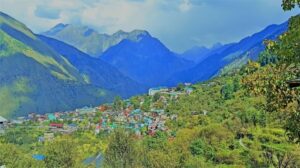
Bharmour, formally known as Brahmpura, was the ancient capital of Chamba state, India. Situated at an altitude of 7000 feet in the Budhil valley (32.26°N 76.32°E), to the south-east of Chamba. Distance between Chamba to Bharmour is 61 km by road. Bharmour is known for its scenic beauty, wildlife sanctuaries, waterfalls and for its ancient temples, hence making it one of the best tourist spots in Himachal Pradesh. Some of the temples are believed to date from 7th century. As the whole area around Bharmour is supposed to belong to lord Shiva, it is popularly spoken of as Shivabhumi, abode of lord Shiva. It is located between the Pir-Panjal and Dhauladhar range, between Ravi and Chenab valley. The land is blessed with deep beauty of abundant alpine pastures and provides home for nomadic shepherds, known as Gaddi, thus also called Gadderan. The foothills are filled with orchards and terraced farmsteads. The epitome of spirituality lies in this land as it is endow with ancient temples. The area goes through inhospitable terrain and severe climate changes. “Kailash Vasio” as the people of Bharmour are known are extremely courteous and welcomes you like their own family member. Along with its ethnic traditions, culture and ancient history, Bharmour forms the perfection of divine splendor.

History of Bharmour

Meru, the father of the first recorded prince Jaistambh in the Chamba Vanshavali was the first to settle Bharmour. He belonged to a ruling family of Ayodhya. Accompanied by his youngest son Jaistambh, Meru penetrated to the upper
Ravi valley through the outer hills. He defeated the petty Ranas holding the territory there and founded the town Brahmpura and made it the capital of a new state. This event is believed to have taken place in the middle of 6th century A.D.
According to one legend, the name Brahampura was in use at a still earlier period for the more ancient kingdom of Bharmour which existed in the territories of Garhwal and Kumaon, and that Maru gave the same name of Brahampura to the state that he founded with present Bharmour as his capital. After Maru, several Rajas ruled in succession until Sahil Varman. It was Sahil Varman who conquered the lower Ravi valley and transferred the seat of government from Brahampura to the new capital he founded at Chamba. Bharmour was capital for probably four hundred years.
The original state was of very small extent and in all likelihood comprised at the most the present Bharmour sub-division i.e. the valley of the Ravi below Bara Bangahal, with its tributaries, the Budhil and the Tundah as far down as Chhatrari.
Bharmour was the Vatika (garden) of goddess Brahmaani
According to a local legend, the place Brahampura was older than Maru’s time and as per common belief this used to be the vatika (garden) of goddess Brahmani who used to reside where her shrine now stands on the ridge at a distance of 3-4 kilometers. Brahmani Devi was having a son who was very fond of his pet chakor or (birds). One day the chakor was killed by a peasant and the son was shocked to death by this loss. Grief-stricken, Brahmani Devi also sacrificed by burying herself alive. The spirits of these trio dead souls started haunting the people awfully who raised Brahmani Devi to the status of deity and built her a temple. The people believe that the place was called Brahmpura after Brahamani Devi.
The legend further says that God Shiva with 84 Sidhas while on his way to Manimahesh happened to visit Brahmpura, the Vatika of the Goddess Brahmani Devi and settle there for the night. When Brahmani Devi, the presiding deity of the place saw the smoke of fires lit by the Sidhas, she felt very angry at this trespass. She came down to the place and ordered Shiva and the Sidhas to get out of the place. Shiva importuned in all his humility for allowing them to spend a night there. Goddess Brahamani condescended to their wishes. The 84 Mahasiddhas transformed themselves into 84 Lingas because they wished to settle there.
The Lord Shiva granted a boon to Brahamani Devi that all persons intending to go on pilgrimage to Manimahesh must have a dip in Bharmani Devi Temple pool. Failing this, their pilgrimage would not be acceptable to Lord Shiva.
In September 2007, the Government of Himachal Pradesh started chopper service to manimahesh located at an altitude of 14,000 ft.
Best time to visit Bharmour is from April to October but Bharmour can be visited throughout the year.
